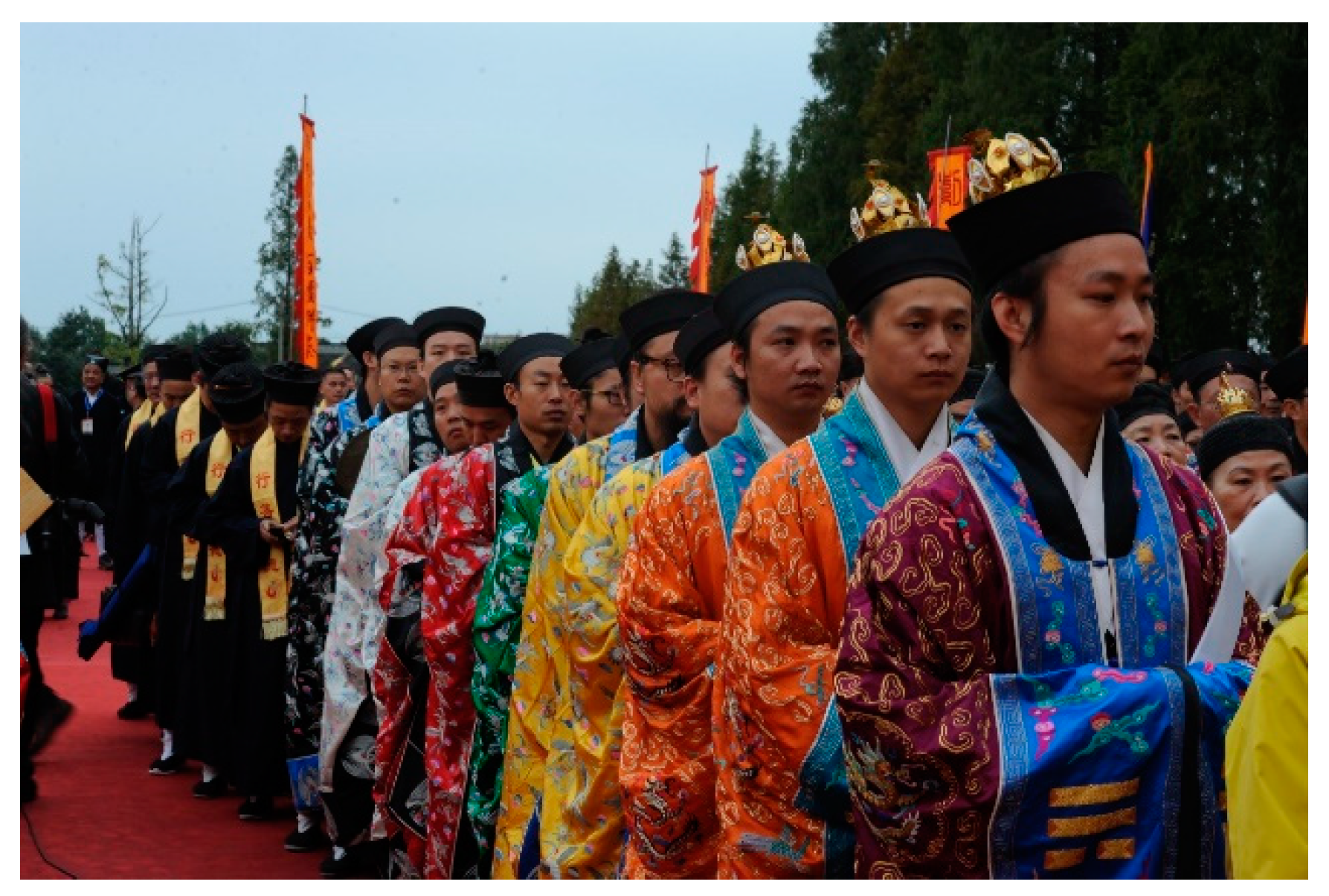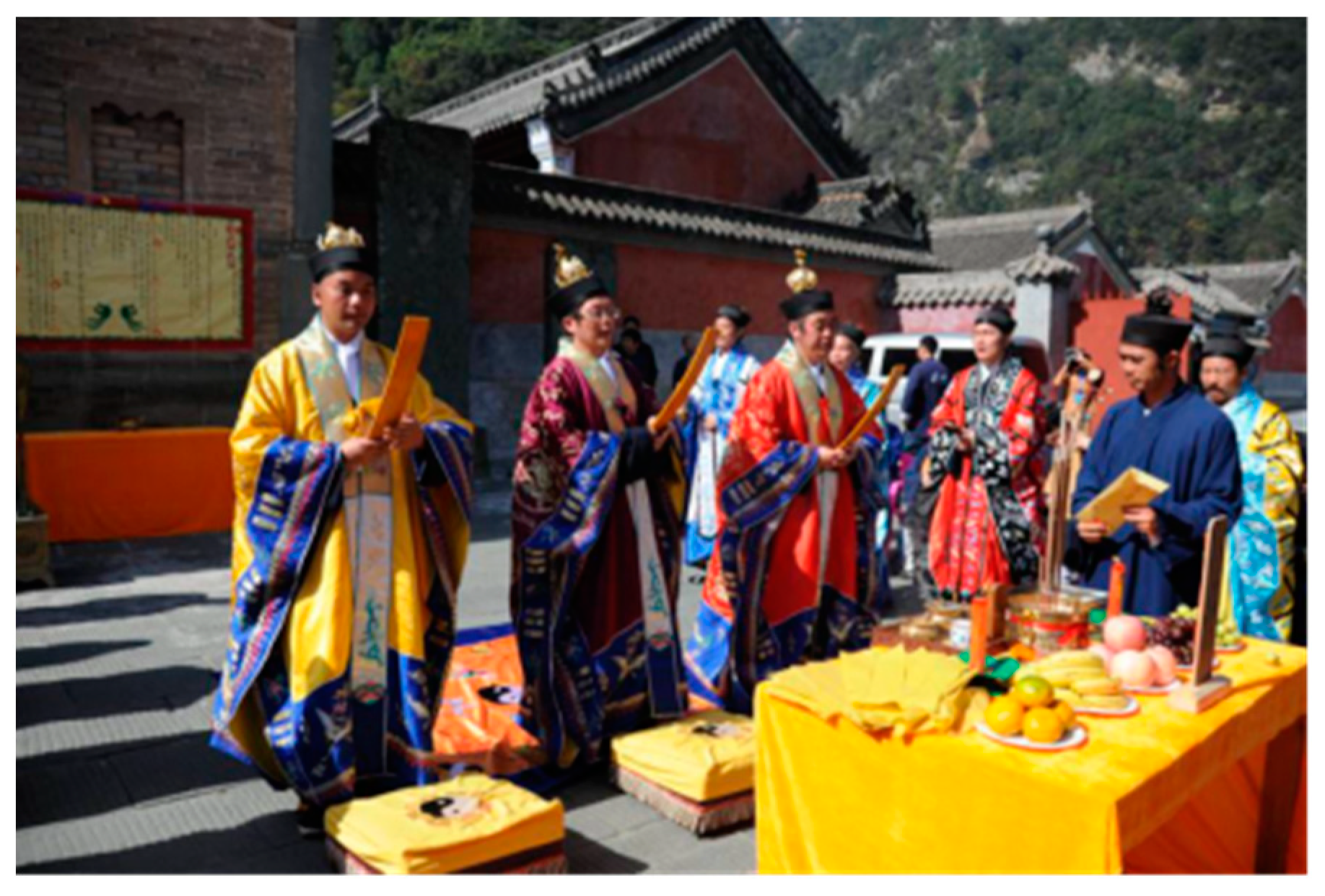An Overview of the Weiyi (威儀 Dignified Liturgies) of Taoism
Abstract
:1. Introduction
2. Weiyi in the History of Taoism
2.1. Weiyi in the Lingbao Retreat
2.2. Taoist Weiyi Masters of the Sui, Tang, and Five Dynasties (581–960)
2.3. Two Street Merit and Virtue Officials (兩街功德使) and Left- and Right-Street Weiyi Masters (左右街威儀) in the Tang Dynasty
3. Dignified Image (威儀形象) of Taoist Priests, Dignified Duties (威儀職責) of Ritual Masters
3.1. Requirements for the Dignified Image of the Taoist Priests
3.2. Requirements for the Ritual Vestments of the Taoist Priests
3.3. Requirements for the Dignified Duties of the Ritual Masters
3.4. Dignified Image of the Divine Immortals
The merit officers, the brave generals, the cavalrymen, the officials of the Three Offices, and the heavenly soldiers each appear in numbers of 340, magnificently dressed and very dignified. 功曹使者、郎吏虎賁、察奸鉤騎、三官僕射、天鄒甲卒等官各三百卌人出。出者嚴莊顯服,正其威儀。
4. Weiyi at the Altar of the Zhai and Jiao Rituals
4.1. Ritual Banners and Streamers at the Zhai and Jiao Altar
Various types of streamers, flags, and fans, including a pair of jie, a pair of chuang, a pair of jing, a pair of fans (幡) with pearls, a pair of wuming fans, and a pair of crane feathers. 節一對,幢一對,旌一對,珠幡一對,五明扇一對,鶴羽一對。(SRSYRR, DZ, vol. 9, p. 383)
A total of 4 pairs of different types of streamers, (jie, chuang, jing, mo), a pair of wuming fans, a pair of feather fans, a pair of ruyi, 12 yellow silk bags, a vermilion wooden box, 2 black lacquered wooden shelves, 5 liang of agila wood, 5 liang of kapur, 50 pieces of new tea, and 100 liang of silver. These 14 ritual tools are called the 14 dignified items in Taoist scriptures. 節、幢、旌、磨、五明扇、羽扇、如意各一對,罩護威儀黃絹袋一十二個、盛威儀朱紅木匣一隻、威儀黑漆立架二座、沉香五兩、腦子五兩、新茶五十片、銀一百兩。此十四種儀仗法器,經書稱之為威儀一十四事。10
Streamers and banners (jing, jie, chuang, pei) are dignified divine instruments. They are classic, dignified liturgical tools now made by the state. 旌、節、幢、旆,亦神仙所持,既具經典及威儀之限,如今國家所制也。(CPWDTC, DZ, vol. 24, p. 754)
The banners and streamers that flutter in the air are a necessary part of the rituals. 幡幢旌節,折旋回環,外儀之事也。(DZ, vol. 4, p. 14)
4.2. Ritual Tools at the Zhai and Jiao Altar
4.3. Ritual Lamps at the Zhai and Jiao Altar
4.4. Weiyi at the State Zhai and Jiao Ritual Altar in Tang and Song
5. Conclusions
Author Contributions
Funding
Institutional Review Board Statement
Informed Consent Statement
Data Availability Statement
Conflicts of Interest
Abbreviation
| 1 | In this article, The Taoist Canon and The Encyclopedia of Taoism are the main references for the translation of scripture titles and terminology in Taoism. |
| 2 | See DZ 9: 378, Jiang shuyu (蔣叔輿 1162–1223) compiled, Standardized Rituals of the Supreme Yellow Register Retreat 無上黃籙大齋立成儀, fasc 1. Abbreviated as SRSYRR in this article. The form of reference for this work is DZ, vol. p. 378, where 9 is the volume number and 378 is the page number. |
| 3 | See DZ 24: 758, Codes and Precepts for Worshipping the Dao of the Three Caverns of Lingbao, Cavern of Mystery Section 洞玄靈寶三洞奉道科戒營始. Abbreviated as CPWDTC in this article. |
| 4 | For relevant studies, see Zhou Qi’s “Examination on the Taoist Weiyi” 道門威儀考 (Shi Lin史林, Zhou 2008, vol. 6, pp. 111–14), which examines the Weiyi Taoist priests of the Tang dynasty, and Liu Kangle’s discussion of the Taoist Weiyi Master in the Taoist official system of the Tang dynasty in his book, A Study of the Taoist Official System in the Middle Ages 中古道官制度研究 (Ba-Shu Publishing House 巴蜀書社 Liu 2013, pp. 162–70). |
| 5 | See DZ 5, p. 273, Comprehensive Mirror of Immortals Who Embodied the Tao through the Ages 歷世真仙體道通鑑. |
| 6 | See DZ 5, p. 603, Chronicle of Maoshan 茅山志. |
| 7 | See DZ 5, p. 560. |
| 8 | About merit and virtue officials, see Zha Minghao 查明昊 (Zha 2009). |
| 9 | See DZ 24, p. 781, Abridged Codes for the Taoist Community of Master Lu 陸先生道門科略. |
| 10 | This is the description of the altar for the sacrifice of the Mao brothers, San Mao Zhenjun, on the 23rd day of the 4th lunar month in Maoshan. See DZ 3, p. 338, Protocol of the Additional Canonization of the Mao Brothers 三茅真君加封事典. |
| 11 | See the lamp ritual part of Instructions for the Study of the Tao of Lingbao, Cavern of Mystery 洞玄靈寶道學科儀, signed Chisongzi (赤松子), in DZ 24. Abbreviated as ISTLCM in this article. |
References
- Asano, Haruji. 2005. Taiwan ni okeru Dōkyō girei no kenkyū 台湾における道教儀礼の研究. Tōkyō: Kasama Shoin. [Google Scholar]
- Blondeau, Anne-Marie, and Kristofer Schipper, dirs. 1988. Essais sur le rituel. Louvain and Paris: Peeters. [Google Scholar]
- Chen, Yaoting 陳耀庭. 2003. Daojiao Liyi 道教禮儀. Beijing: Religion Culture Publishing House. [Google Scholar]
- Daozang 道藏. 1988. Taoist Canon. Beijing: Cultural Relics Press. Shanghai: Shanghai Bookstore Publishing House. Tianjin: Ancient Books Publishing House. [Google Scholar]
- Dean, Kenneth. 1995. Taoist Ritual and Popular Cults of Southeast China. Princeton: Princeton University Press. [Google Scholar]
- Deng, Mu 鄧牧. 1987. Dongxiao illustrated Gazetteer 洞霄圖志. In Complete Library in Four Sections 文淵閣四庫全書. Shanghai: Ancient Books Publishing House, vol. 5. [Google Scholar]
- Dong, Hao 董诰, Yuan Ruan 阮元, Song Xu 徐松, and Chenghong Hu 胡承洪. 1966. Collection of Preserved Prose Literature from the Tang Dynasty 全唐文. Beijing: Zhonghua Book Company. [Google Scholar]
- Editorial Board. 2002. Extension of Complete Library in Four Sections 續修四庫全書. Edited by Yanlong Gu 顾廷龙 and Xuancong Fu 傅璇琮. Shanghai: Ancient Books Publishing House. [Google Scholar]
- Ji, Yun 纪昀. 1987. Complete Library in Four Sections 文淵閣四庫全書. Shanghai: Ancient Books Publishing House. [Google Scholar]
- Kohn, Livia. 2003. Monastic Life in Medieval Daoism: A Cross-Cultural Perspective. Honolulu: University of Hawai’i Press. [Google Scholar]
- Lagerwey, John. 1986. Taoist Ritual in Chinese Society and History. New York: Macmillan Pub Co. [Google Scholar]
- Lagerwey, John. 2010. China: A Religious State. Hong Kong: University of Hong Kong Press. [Google Scholar]
- Lai, Chi Tim 黎志添, Chi-On Yao 遊子安, and Zhen Wu 吳真. 2007. The History and Heritage of Taoist Ceremonies in Taoist Temples in Hong Kong 香港道堂科儀歷史與傳承. Hongkong: Chung Hwa Book Company. [Google Scholar]
- Lee, Fong-mao 李豐楙, and Conghui Xie 謝聰輝. 2001. Taiwan Zhaijiao 臺灣齋醮. Taipei: National Center for Traditional Arts. [Google Scholar]
- Li, Linfu 李林甫. 1992. Collection of Official Statutes of the Tang Dynasty 唐六典. Proofread by Zhongfu Chen 陈仲夫. Beijing: Zhonghua Book Company. [Google Scholar]
- Lin, Xilang 林西朗. 2006. Tangdai daojiao guanli zhidu yanjiu 唐代道教管理制度研究. Chengdu: Ba-Shu Publishing House. [Google Scholar]
- Liu, Jih-Wann 劉枝萬. 1967. Great Propitiatory Rites of Petition for Beneficence at Sungshan, Taipei, Taiwan 臺北市松山祈安建醮祭典:臺灣祈安醮祭習俗研究之一. Taipei: Institute of Ethnology, Academia Sinica. [Google Scholar]
- Liu, Kangle 劉康樂. 2013. A Study of the Taoist Official System in the Middle Ages 中古道官制度研究. Chengdu: Ba-Shu Publishing House. [Google Scholar]
- Lü, Pengzhi 呂鵬志. 2008. Tang qian daojiao yishi shigang 唐前道教儀式史綱. Beijing: Zhonghua Book Company. [Google Scholar]
- Maruyama, Hiroshi. 2004. Dōkyō girei monjo no rekishiteki kenkyū 道教儀禮文書の歴史的研究. Tōkyō: Kyūko Shoin. [Google Scholar]
- Ninji, Ōfuchi 大淵忍爾. 2005. Chūgokujin no shūkyō girei, dōkyō hen 中国人の宗教儀礼, 道教篇. Tōkyō: Fūkyōsha. [Google Scholar]
- Pregadio, Fabrizio. 2008. The Encyclopedia of Taoism, 2 Vols. London: Routledge. [Google Scholar]
- Ruan, Yuan 阮元. 1980. Commentaries and Explanations to the Thirteen Classics 十三經注疏. Beijing: Zhonghua Book Company. [Google Scholar]
- Schipper, Kristofer, and Franciscus Verellen, eds. 2006. The Taoist Canon: A Historical Companion to the Daozang. Chicago and London: The University of Chicago Press. [Google Scholar]
- Seidel, Anna. 1988. Review of Early Taoist Ritual, by Ursula-Angelika Cedzich. Cahiers d’Extrême-Asie 4: 199–204. [Google Scholar]
- Tuo, Tuo 脱脱. 1985. History of the Song Dynasty 宋史. Beijing: Zhonghua Book Company. [Google Scholar]
- Wang, Qinruo 王钦若, and Yi Yang 杨亿. 1988. Prime Tortoise of the Record Bureau 冊府元龜. Beijing: Zhonghua Book Company, vol. 2. [Google Scholar]
- Wu, Gang 吴钢. 2005. Supplement of Collection of Preserved Prose Literature from the Tang Dynasty 全唐文補遺. Xi’an: Three Qin Publishing House. [Google Scholar]
- Xie, Shiwei 謝世維. 2010. Poan zhuyou: Gu Lingbao jing zhong de randeng yishi 破暗燭幽:古靈寶經中的燃燈儀式. Bulletin of Chinese 6: 99–130. [Google Scholar]
- Zha, Minghao 查明昊. 2009. The rise and fall of eunuch power as reflected in the change of the post of Merit and Virtue Officials during the Tang and the Five Dynasties 從唐五代功德使一職的變遷看宦官勢力的消漲. Religious Studies 3: 67–73. [Google Scholar]
- Zhang, Chaoran 張超然. 2015. Tangsong daojiao zhaiyi zhong de <lishi cunnian> jiqi yuanliu kaolun: Jianlun daojiao zhaitan tuxiang de yunyong 唐宋道教齋儀中的〈禮師存念〉及其源流考論——兼論道教齋壇圖像的運用. Qinghua Xuebao 清華學報 45: 381–413. [Google Scholar]
- Zhang, Zehong 張澤洪. 1996. An analysis of the origins of Taoist zhai and jiao rituals 道教齋醮源流芻析. Religious Studies 3: 26–31. [Google Scholar]
- Zhang, Zehong 張澤洪. 1999. Daojiao zhaijiao Fuzhou yishi 道教齋醮符咒儀式. Chengdu: Ba-Shu Publishing House. [Google Scholar]
- Zhou, Qi 周奇. 2008. Examination on the Taoist Weiyi 道門威儀考. Shi Lin史林 6: 111–14. [Google Scholar]








Disclaimer/Publisher’s Note: The statements, opinions and data contained in all publications are solely those of the individual author(s) and contributor(s) and not of MDPI and/or the editor(s). MDPI and/or the editor(s) disclaim responsibility for any injury to people or property resulting from any ideas, methods, instructions or products referred to in the content. |
© 2023 by the authors. Licensee MDPI, Basel, Switzerland. This article is an open access article distributed under the terms and conditions of the Creative Commons Attribution (CC BY) license (https://creativecommons.org/licenses/by/4.0/).
Share and Cite
Zhang, Z.; Luo, Y. An Overview of the Weiyi (威儀 Dignified Liturgies) of Taoism. Religions 2023, 14, 779. https://doi.org/10.3390/rel14060779
Zhang Z, Luo Y. An Overview of the Weiyi (威儀 Dignified Liturgies) of Taoism. Religions. 2023; 14(6):779. https://doi.org/10.3390/rel14060779
Chicago/Turabian StyleZhang, Zehong, and Yang Luo. 2023. "An Overview of the Weiyi (威儀 Dignified Liturgies) of Taoism" Religions 14, no. 6: 779. https://doi.org/10.3390/rel14060779



